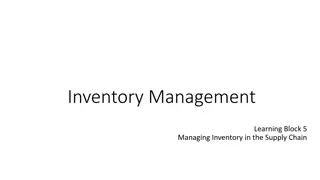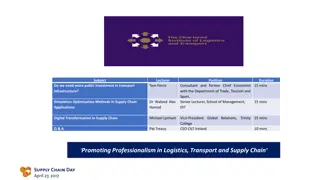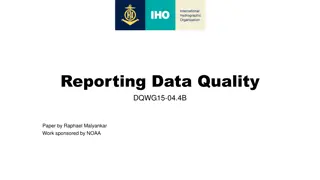
How to Manage Supply Chain Disruptions with BI Reporting Tools as Global Dynamics Shift
In this insightful blog, discover how Business Intelligence reporting tools can be your strategic asset in managing supply chain disruptions amidst changing global dynamics. Learn how these powerful tools help navigate through challenges posed by geopolitical tensions, pandemic recovery, and evolving trade policies.
Download Presentation

Please find below an Image/Link to download the presentation.
The content on the website is provided AS IS for your information and personal use only. It may not be sold, licensed, or shared on other websites without obtaining consent from the author. Download presentation by click this link. If you encounter any issues during the download, it is possible that the publisher has removed the file from their server.
E N D
Presentation Transcript
How to Manage Supply Chain Disruptions with BI Reporting Tools as Global Dynamics Shift --------------------------------------------------------------- With the world becoming more interconnected every day, global supply chains face many unprecedented challenges. Did you know that, according to recent studies, nearly 75% of companies have encountered significant disruptions in their supply chain models due to geopolitical tensions, the uneven recovery from the global pandemic, and shifts in trade policies? These complexities and instabilities into logistics and operations. dynamics are reshaping the landscape of global trade, introducing As businesses worldwide navigate these turbulent waters, how can they not only survive but also thrive? Business Intelligence (BI) reporting tools are useful in this situation. These tools are crucial in today's economy, enabling companies to make data-driven decisions that are more informed and timely than ever before. With BI tools, businesses can analyze complex data sets, predict future trends, and effectively respond to rapidly changing conditions. Why are these BI reporting tools indispensable in the current economic climate? As we explore how to manage supply chain disruptions with BI reporting tools, it's clear that these technologies are not just beneficial they are essential. By embracing BI, companies can transform challenges into opportunities, ensuring continuity and efficiency amid global shifts. How ready is your business to adapt and excel in this new environment? Types of Supply Chain Disruptions Logistical Delays Logistical delays refer to the unexpected lag in the transportation and delivery of goods. These can be caused by a variety of factors including port congestions, customs delays, inadequate transport infrastructure, weather conditions, and regulatory changes. Suppose major ports have a backlog due to sudden changes in import-export regulations or strikes by transport workers. BI tools can help by providing real-time tracking of shipments and predictive analytics to foresee such delays, allowing companies to reroute shipments or adjust schedules proactively. Supplier Insolvency
Supplier insolvency occurs when a key supplier in the supply chain goes bankrupt or is financially unable to meet its obligations. This could be due to poor cash flow management, loss of market, or economic downturns. For instance, if a major component supplier for manufacturing electronics files for bankruptcy, it could halt production lines. BI tools can mitigate this risk by continuously monitoring supplier health indicators like financial performance, credit scores, and market conditions, alerting decision-makers to potential risks. Fluctuating Demand Demand fluctuations are significant variations in customer demand which can be seasonal, trend-based, or influenced by external economic factors. These fluctuations challenge inventory management and operational planning. A classic example is the surge in demand for home fitness equipment during the COVID-19 pandemic. BI reporting tools can analyze historical sales data, seasonal trends, and market forecasts to help companies adjust their inventory and production schedules dynamically to meet changing demand. Impact on Business Operations Operational Efficiency Disruptions like logistical delays or supplier issues directly affect the efficiency of operations. They can lead to increased cycle times, missed delivery deadlines, and ultimately, customer dissatisfaction. By integrating BI reporting tools, businesses can set up dashboard alerts for performance anomalies and drill down into data to quickly identify and address the root causes of inefficiencies. Profitability Unplanned costs due to expedited shipping, increased inventory holding costs, or production downtimes all chip away at profitability. Business Intelligence reporting tools help in modeling various cost scenarios and their impact on the bottom line, enabling more informed budgeting and financial planning. Growth and Scalability Persistent supply chain disruptions can stifle a company s ability to grow and scale. For example, the inability to meet demand consistently can tarnish a brand's reputation and drive customers to competitors. 2
Advanced analytics and forecasting models can predict demand spikes and dips, helping businesses to scale operations up or down as needed without compromising on service quality or operational costs. Key Features of Effective BI Tools for Supply Chain Management Dashboard and Visualization Capabilities Significance of Intuitive Dashboards and Data Visualization: Operational Insight: Intuitive dashboards are crucial for displaying complex data in an easily digestible format. Business Intelligence dashboard tools allow managers to see metrics like inventory levels, supplier performance, and logistics operations at a glance, which is essential for quick decision-making. Customization and Interactivity: Effective BI dashboard tools are customizable to reflect key metrics that are specific to a company s operational needs. For instance, a dashboard might track real-time shipment status, alert managers about delays, and even enable users to drill down into specific data points. Consider a scenario where a logistics manager uses a BI dashboard to monitor global shipments. The dashboard visualizes data through maps and graphs showing route efficiency, shipment status, and predicted arrival times, allowing the manager to make proactive decisions that streamline operations. Predictive Analytics Forecasting Potential Supply Chain Issues: Anticipating Disruptions: Predictive analytics in BI reporting tools harness historical data, current trends, and algorithms to forecast potential supply chain disruptions. This might involve predicting the impact of seasonal demand spikes or supplier shortages before they critically impact the supply chain. For instance, 2 Brothers Moving & Delivery utilized Grow to streamline their data visualization, enhancing their team's ability to quickly adapt to operational demands. Risk Management: By forecasting potential issues, businesses can strategize preventive measures, like diversifying suppliers or adjusting inventory levels ahead of peak periods. A BI tool might analyze years of sales data to predict upcoming demands for various products. This foresight allows a company to adjust its production schedules and 3
inventory levels accordingly, avoiding overproduction or stockouts and ensuring optimal operational flow. Integration with Other Systems Holistic View Through System Integration: Seamless Data Flow: Integration capabilities of Business Intelligence reporting tools with other enterprise systems (like ERP and CRM) are vital for a unified view of operations. This integration allows data to flow seamlessly between systems, providing a comprehensive snapshot of business health and supply chain status. Enhanced Decision Making: With integrated BI reporting tools, data from across the organization can inform supply chain decisions. For example, CRM data about customer trends can directly influence inventory management and procurement strategies. In a retail business, integrating BI tools with ERP and CRM systems can synchronize sales data with supply chain operations. This synchronization helps in maintaining optimal inventory levels based on real-time sales trends, promotional impacts, and customer feedback, leading to improved customer satisfaction and reduced carrying costs. Through these specific features of Business Intelligence reporting tools, businesses can not only monitor and manage their supply chains more effectively but also anticipate and adapt to changes proactively. This strategic application of technology ultimately supports robust, responsive, and efficient supply chain operations, critical to sustaining competitive advantage in a dynamic global market. Conclusion As global dynamics continue to shift and challenge traditional supply chain models, the strategic use of Business Intelligence reporting tools becomes ever more critical. These tools empower businesses to not only visualize and react to current conditions but also anticipate and mitigate potential disruptions before they can impact the bottom line. Grow, with its robust BI capabilities, stands as a premier solution for managing these complexities. By integrating Grow's BI tools into your supply chain management strategy, you can ensure a resilient operation capable of adapting to global shifts and uncertainties. The intuitive Business Intelligence dashboard tools, predictive analytics, and seamless integration with existing systems provide a comprehensive view of your supply chain, enabling you to make informed decisions swiftly and efficiently. 4
Take the first step towards transforming your supply chain management by exploring what Grow can offer. We encourage you to sign up for a 14-day free trial of Grow and experience firsthand how our BI tools can fortify your supply chain against disruptions. For more detailed information on how Grow can cater to your specific business needs, including an in-depth analysis of costs and features, visit "Grow Reviews Cost & Features on GetApp." Embrace the power of advanced BI with Grow and turn global supply chain challenges into opportunities for growth and innovation. Original Source: https://businessintelligencedashboardtools.blogspot.com/2024/05/ho w-to-manage-supply-chain-disruptions.html 5






















